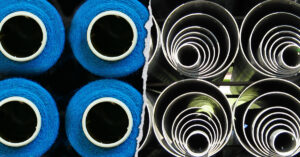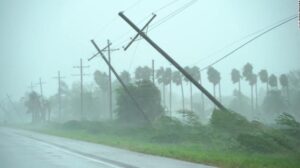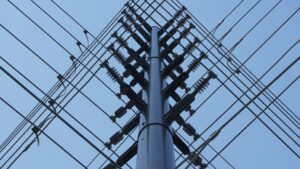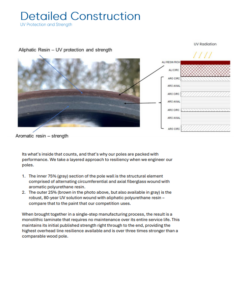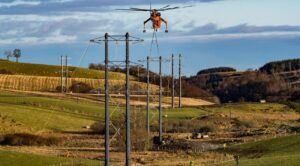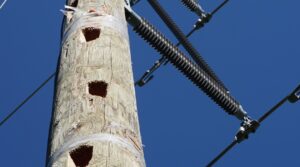Challenge: Building resiliency into critical structures and circuits is at the core of improving a utility’s overall system reliability. The cost and impact of failure is immense. When critical structures fail, the electric equipment (transformers, reclosers, etc.) they support also go out of service. Often the equipment is damaged and unusable. These poles and their associated equipment then take longer and cost more to restore in spite of their importance to the system. Similarly, critical circuits are mission critical for infrastructure, hospitals, and other key community services. Their failure has a profound impact on the community and local economy. Investing to protect these important assets is a strategic imperative for leading utilities. Age, exposure to the elements, and extended replacement cycles lead to the gradual degradation of the average strength of wood structures. These structures are then far more prone to fail when facing challenges such as:Severe Weather The impact of severe weather on electric infrastructure is unmistakable. Hurricanes, tornados, derecho winds, and ice storms have devastated communities across North America. Fires WIldfires are increasingly a risk that cannot be ignored. From pole top fires originating on the structure itself to naturally caused wildfires burning utility structures, the impact on critical structures and circuits is the same. It takes only minutes for fire to cause a wood structure to fail. Ice Storms Heavy ice buildup on overhead lines and equipment places extreme pressure on the poles supporting them. Without the ability to absorb the elastic strain, failure of these critical structures and circuits is increasingly inevitable. Solution: Targeted use of composite poles on critical structures and circuits can dramatically improve the overall performance of an electric system. Wood, and alternative poles will always have a role as utility structures, but when it comes to protecting a utility’s most important assets, nothing surpasses the performance of composites. Composite poles from Resilient Structures are engineered to perform in all extreme weather conditions. The advanced material science ensures an engineered pole capable of ensuring the mission-critical operation of selected elements of the system. Resilient Structures composite poles are strong and resilient thanks to advanced design and company support: The mean ultimate strength of our composite poles is up to 100% greater than the published strength, substantially more than that of other engineered materials. Resilient Structures poles are non-conductive and do not support combustion, mitigating fire threats Our composite poles absorb significant elastic strain energy in high-load situations, with the ability to prevent cascading failures of adjacent wood or steel poles. A dedicated and qualified team of experienced engineers is ready to partner with structural analysis, hardware review and drawings specifically for your project Every Resilient Structure pole features a 41-year limited warranty and a projected service life of 80+ years. High Load and Hurricane Evidence: In December 2021, a series of record-setting tornadoes tore through Western Kentucky. After the tornadoes had passed Hopkinsville, within the service territory of Pennyrile RECC, over two miles of 13kV wood distribution poles lay on the ground from a wind-load-induced cascading failure. However, three Resilient Structures composite poles installed in 2012 stopped three different cascading wood pole failure events on the circuit, preventing further damage to the system and protecting nearby critical substation components. Similarly, Resilient Structures poles used on a 22-mile, 69kV line in Grand Bahama have repeatedly proven their resilience to hurricanes. In 2016, the island was hit by Hurricane Matthew, a Category 4 storm with winds of 140 mph. A direct hit destroyed approximately 10% of the area’s poles, over 2,300 in all. As the restoration efforts began, it became clear that Resilient Structures composite poles stood strong during the hurricane, with zero failures Then, in 2019, Category 5 Hurricane Dorian brought wind gusts up to 220 mph and $7 billion in damage. However, a text message from Grand Bahama Power Vice President Frank Woodworth confirmed that the Resilient Structures composite poles had survived… “again.” Fire and Ice Storm Evidence: Resilient Structures is a pioneer in engineering utility pole solutions to address the growing risk of failure due to fire and ice. Faced with an intensifying challenge and desperate to mitigate their fire threat risk, California’s utilities needed a pole that would not burn. Newly named gigafires, fires that destroy 1 million acres or more, were wreaking havoc, but Resilient Structures had a solution. In 2011, unsatisfied with the existing industry fire tests, Resilient Structures partnered with University of Alberta fire expert Mark Ackerman to develop a full-scale test that simulated the realities of a wildfire. This test, known as the RS-Ackerman Fire Test, has become the industry standard all California utilities use to evaluate a pole’s fire performance. Resilient Structures composite poles passed the test and outperform the alternatives, making them safer for line crews and the public. On the opposite end of the spectrum, Kentucky experienced a severe ice storm in January 2009 that caused $240 million in damage to jurisdictional utilities alone. West Kentucky Electrical Co-operative (WKREC) was already in the process of a pilot evaluation of 10 Resilient Structures poles when this disaster struck. The high-performance Resilient Structures poles went undamaged in the storm and even carried the load of a neighboring steel pole when it collapsed. The superior resiliency and reliability demonstrated here provided unyielding confidence in Resilient Structures poles – which are now used not only in the WKREC’s highest priority sections of their grid but many other global utilities as well.
